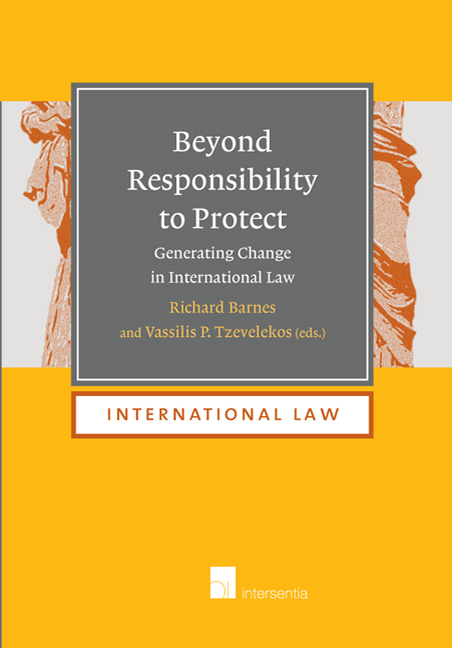Book contents
- Frontmatter
- Dedication
- Foreword
- Acknowledgements
- Contents
- Table of Cases
- List of Authors
- Introduction
- Part I The Moral Underpinnings and Political Ends of R2p
- Part II International Institutions And Their Role In R2p
- PART III De Facto Regimes and Non-State Actors Within a State And as a State
- Part IV R2p and Due Dilligence Regarding the Conduct of Corporations
- Part V The Interaction Between R2p And Humanitarian Law Obligations To Protect Civilian Populations
- PART VI R2p and International Criminal Law Beyond the Four R2p Crimes
- The Place of Aggression in the Responsibility to Protect Doctrine
- The Impact of the Responsibility to Protect on the Protection of Peacekeeping Missions under the Rome Statute of the International Criminal Court
- Commentary: R2P and its Consequences for International Criminal Law: Crimes as a Justification for the Use of Force
- Part VII R2p and its Possible Impact on the Law of International Responsibility
- Part VIII Concluding Observations
- Index
The Place of Aggression in the Responsibility to Protect Doctrine
from PART VI - R2p and International Criminal Law Beyond the Four R2p Crimes
Published online by Cambridge University Press: 19 September 2018
- Frontmatter
- Dedication
- Foreword
- Acknowledgements
- Contents
- Table of Cases
- List of Authors
- Introduction
- Part I The Moral Underpinnings and Political Ends of R2p
- Part II International Institutions And Their Role In R2p
- PART III De Facto Regimes and Non-State Actors Within a State And as a State
- Part IV R2p and Due Dilligence Regarding the Conduct of Corporations
- Part V The Interaction Between R2p And Humanitarian Law Obligations To Protect Civilian Populations
- PART VI R2p and International Criminal Law Beyond the Four R2p Crimes
- The Place of Aggression in the Responsibility to Protect Doctrine
- The Impact of the Responsibility to Protect on the Protection of Peacekeeping Missions under the Rome Statute of the International Criminal Court
- Commentary: R2P and its Consequences for International Criminal Law: Crimes as a Justification for the Use of Force
- Part VII R2p and its Possible Impact on the Law of International Responsibility
- Part VIII Concluding Observations
- Index
Summary
INTRODUCTION
Since its conception, the responsibility to protect (R2P) doctrine has rapidly become a crucial framework for the prevention of and reaction to international crimes. The doctrine aims to protect civilian populations from genocide, war crimes, crimes against humanity, and ethnic cleansing. What these crimes have in common is that the threat posed is of an internal character: they are usually perpetrated by governments or non-state actors against their own populations. This might explain why R2P does not address the crime of aggression. In the case of aggression, the crime is perpetrated by a foreign state, and the threat to a population is external. Although this determining characteristic of aggression seems to explain its exclusion from R2P's scope, it is necessary to consider whether, given R2P's objective to protect civilian populations from mass atrocities, the doctrine should also cover cases of aggression.
That being explained, the aim of the chapter is to discuss de lege ferenda the scenario of a broadened R2P doctrine that would encompass aggression. Two main points are made in that respect. First, it is argued that the protective purpose of R2P supports its extension to the crime of aggression. Second, that R2P may offer a useful framework for coordinating decentralised state reaction against acts of aggression. These two points rest on two assumptions. First, R2P – with no regard to whether it is a concept, a principle, soft law or an emerging norm – is already part of international law, in the sense that it has entered the language of international law and so exerts a certain semantic influence. Consequently, it is affected by the practice of states and institutions, and it is inevitably compared with and juxtaposed to other international norms.
Second, R2P has an impact on international law: it develops and shapes concepts, rules and practices that fall within its system. The doctrine has gained ground in international rhetoric and policy, and its application in the fight against international crimes – in various forms or contiguous legal tools – cannot leave international law unaffected. Thus, it is the author's opinion that there exists a mutual influence or interaction between R2P and international law.
- Type
- Chapter
- Information
- Beyond Responsibility to ProtectGenerating Change in International Law, pp. 299 - 320Publisher: IntersentiaPrint publication year: 2016
- 1
- Cited by



